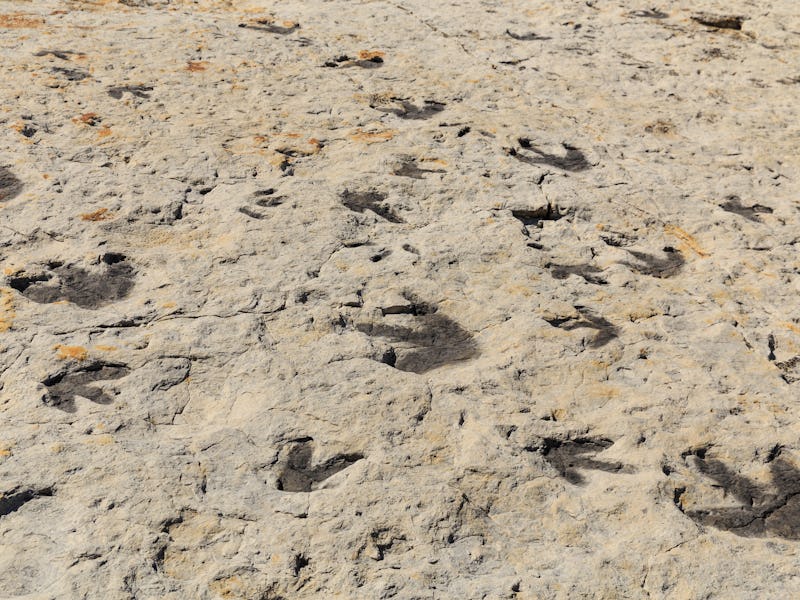Strange, fossilized tracks reveal the footsteps of an injured dinosaur
Ouch!

129 million years ago, a theropod dinosaur trekked through a wetland in eastern Spain. But something was seriously wrong with its left foot.
Therapods distinctively have three long front toes, but this one seemed to be missing a digit. Sporadic, short markings indicated that something happened to its innermost toe.
It’s likely that the dinosaur was injured — a conclusion that researchers came to after rigorously studying a set of mysterious, well-preserved tracks. Researchers writing in the journal PLOS One this week pieced together the story of the injured theropod. Its strange gait and deformed toe tell a tale of adaptation, and also shed light on why birds — the descendants of theropods — are still prone to the same kind of foot injuries.
The mysterious tracks – When the theropod tracks were first discovered, it wasn’t immediately obvious to researchers studying them why they looked so weird.
“We had to resolve many initial questions,” Angela D. Buscalioni, a paleontologist and co-author of the study, tells Inverse. Were the tracks made by one individual or several? Was it possible that the tracks were deformed during the fossilization process?
For the study, experts from several disciplines analyzed different details from the tracks to better understand the individual who made them.
This graphic shows a side by side comparison of what the theropod’s feet may have looked like, based on its tracks.
The site where the tracks were found, called Las Hoyas, has preserved numerous animal remains and trackways due to its unique historic climate. Once a freshwater wetland, its plentiful microbes would engulf dead animals and their footprints, molding and replicating their remains in the fossilization process.
But the fossils at Las Hoyas look a bit peculiar thanks to the microbes’ work. “The footprints are not beautiful [and] do not have perfect shapes,” Buscalioni says. In the case of the therapod’s tracks, “the microbial mat was able to record many other significant details such as nails scratches, folds, and many fish traces around.”
To get a clearer view of the theropod tracks, the researchers made 3D models and compared them to prints left behind by other dinosaurs. They sussed out the main details: The tracks were made by one dinosaur who had a peculiar gait, and it’s likely that a deformity was to blame.
How the dinosaur walked – Finding remains of injured or sick dinosaurs isn’t uncommon, but researchers haven’t really found that many foot deformities. Buscalioni says that from the Early Jurassic to the Late Cretaceous, only 15 trackways showing foot deformities in dinosaurs have been uncovered. That time period spans 125 million years.
Theropods, which walked on two legs, were prone to toe injuries.
For theropods, a deformed inner toe is more common than other foot injuries. That’s what plagued the individual who left behind tracks at Las Hoyas.
“Frequently, a typical theropod trackway is narrow, with longer strides and with left and right footprints almost aligned,” Buscaloni says. But this dinosaur walked with a much wider gait and took smaller steps.
The animal appeared to have dealt with the deformed toe for a long period of time; it wasn’t a temporary injury. That’s because the animal appeared to press its entire foot on the ground, and also seemed to take regularly-spaced steps.
And while it’s unclear how the dinosaur became injured, its odd foot anatomy sheds light on why some animals today are prone to the same deformities.
Thanks, evolution – The feet of theropods look a lot like that of chickens. Both animals have three-toed feet, with a fourth toe on the back of the leg.
Chicken feet.
Considering that chickens evolved from theropods, it’s no coincidence that poultry often have toe deformities as well. Their innermost toes can become crooked or bent, and theropods may have suffered from the same problem.
Those deformities typically arise due to genetics, environmental factors, or dietary deficits, the researchers write. Other birds, such as domestic ostriches, have also been documented with toe deformities as well.
Because of the evolutionary connection between dinosaurs and birds, “it is interesting to find out equivalences in their pathologies,” Buscalioni says.
And the injured theropod at Las Hoyas likely wasn’t the only one. If the prevalence of foot injuries in birds is any indication, many more deformed dinosaurs could have been hobbling around.
This article was originally published on